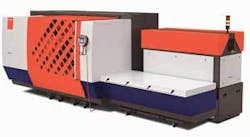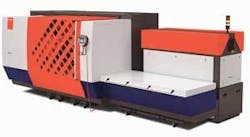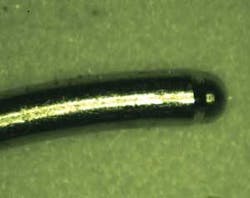All-inclusive solution
Niederönz, Switzerland - ByVention 3015 is a simple to operate (1/2 day training), minimal floor space (400 ft2), continuous flow (auto unload), highly reliable (no maintenance cost), and complete (everything included) laser cutting system.
Powered by a 2.2kW Bylaser 2200 CO2 laser, this unit can produce quality cuts in mild steel (≤ 0.3in), stainless steel (≤ 0.25 in), and aluminum (≤ 0.16 in) all in sheet sizes up to 60 x 120 in. Because the cutting area is 61.5 x 30.4 in, the ByVention cuts nested parts through continuous flow; after the cut area has been processed a separation cut is made and parts are removed while a fresh sheet surface is indexed into the cutting area.
A simple to learn and operate control concept, touch screen, compactly packaged, guides the operator through the procedures. Utilizing Bysoft 6.7.1 to generate cutting plans, the operator can chose nesting strategies to incorporate overlapping and non-overlapping segmentation to produce the continuous flow cutting operation. Programming is intuitive and easy to learn; only 90 minutes is required before an operator can use the control to cut parts.
The cutting system positioning speed (~ 5500 in/min), accuracy (±0.004 in.), and repeatability (± 0.002 in.) are assured through use of an integral frame design that utilizes a high-precision mineral casting. The CO2 laser is integrated into the machine frame, as are the sheet feeder and covered part unload stations.
The heart of the system, the material flow concept, is a departure. Operators will have to learn to nest parts so that they are optimal for the cutting rectangle or use the software to nest parts that overlap the cutting rectangle. But it is this process that allows the ByVention to occupy less than half the floor space of other laser cutters that handle similar material thicknesses and sizes. Shuttle tables are not necessary.
The ByVention is packaged and shipped complete (even a two tank supply of pre-mixed laser gas), ready to be located on the customer’s floor and connected to existing utilities anywhere in the world. Setup is a mere 2 ½ hours, and after a short training period the system can be production cutting metal in less than two days. And all of this is covered by one global selling price that is all inclusive, including shipping and handling.
For more on this innovative, imaginative laser cutter go to www.bystronic.com.
Welding medical devices
Novi, MI-Current drivers to implement or improve laser welding processes for medical devices are better yield, faster cycle times, and smaller joints. Pulsed Nd:YAG lasers can weld most metals used in medical devices, including Nitinol, titanium, cobalt-chromium, and platinum. Stainless steels can also be welded, as long as the chromium-to-nickel ratio of the alloy is greater than 1:7.
CW/modulated lasers, such as fiber lasers, with good beam quality offer additional options. Where process speed is a main requirement, high duty cycle or CW keyhole welding offer an alternative. Also, CW welds show superior surface finish, where the surface of the weld does not show the typical overlap pulses, but just the natural striations of the weld.
The main requirement for spot welding is reproducibility. Having the laser as a stable tool allows greater tolerances within tooling and the materials. If all these are given, it will lead to a lowered spread in general weld characteristic and tensile strength.
Laser welding interconnects are a prime example for laser spot welding. It results in a much stronger mechanical joint than ultrasonic processes and allows the use of materials that are incompatible with ultrasonic bonding. Both ribbon and round wire can be welded, with the pulsed Nd:YAG’s top hat profile being better for ribbon welding, and the Gaussian beam of a fiber laser having distinct advantage with round wire. Materials include nickel, nickel-clad copper, aluminum, titanium, steel, and several others pertinent to the medical device industry.
Welding of platinum wires to Pt/Ir parts (see photo) is required in many medical applications, for example, in the welding of lead wires to electrodes. Resistance welding leads to relatively low yields; laser welding in an automated machine with a highly stable laser yields much better reproducibility and hence yield. This is especially true where several of these parts are used in series, and one bad weld results in rejection of the entire part.
While Nd:YAG lasers are established and offer advantages in peak power, new laser types, such as fiber lasers, are starting to be used for ever finer applications that require high accuracy and repeatability.
This article was adapted with permission from a paper presented by Silke Pflueger, Rick Weisbarth, and Tony Hoult (SPI) at Advanced Laser Applications Conference 2006 (ALAC 2006; www.alac-iluc.org).
No smoke and mirrors
After reading the My View column, “It’s all about choices,” in the September 2006 issue of ILS, Elizabeth Kautzmann, product manager laser technologies for Salvagnini America Inc., shared the following anecdote with us.
“Our first laser sale went down in somewhat of a similar manner as the one you described, though not as dramatic as paying on the spot. Three Southerners came into the Salvagnini booth to see the ‘panel bender’ while they waited for a competitor to give them the time of day.
That same competitor had told them to come to the show, bring their file, and watch the system run their parts. Only glitch-once the good old boys showed up floppy in hand, the competitor said, “We only do custom stuff after hours or at the end of the show’s run.” Well, only having devoted one-half day to the show, they opted on walking around and making the best of it. Because the line for a pretzel was too long, one of the men spotted the Salvagnini sign and always liked watching the panel bender run. To his shock, we did not have the panel bender but a laser. To his even greater shock, we agreed to run his parts on the closest material we had to the spec. To his delight, we had his own programmer program the part and operate the laser-no smoke and mirrors. One hour later he scheduled a meeting at his plant, and the rest is history.
Choices, being willing to grant a specific request, and delivering valuable information: that is what gets the job done.”


